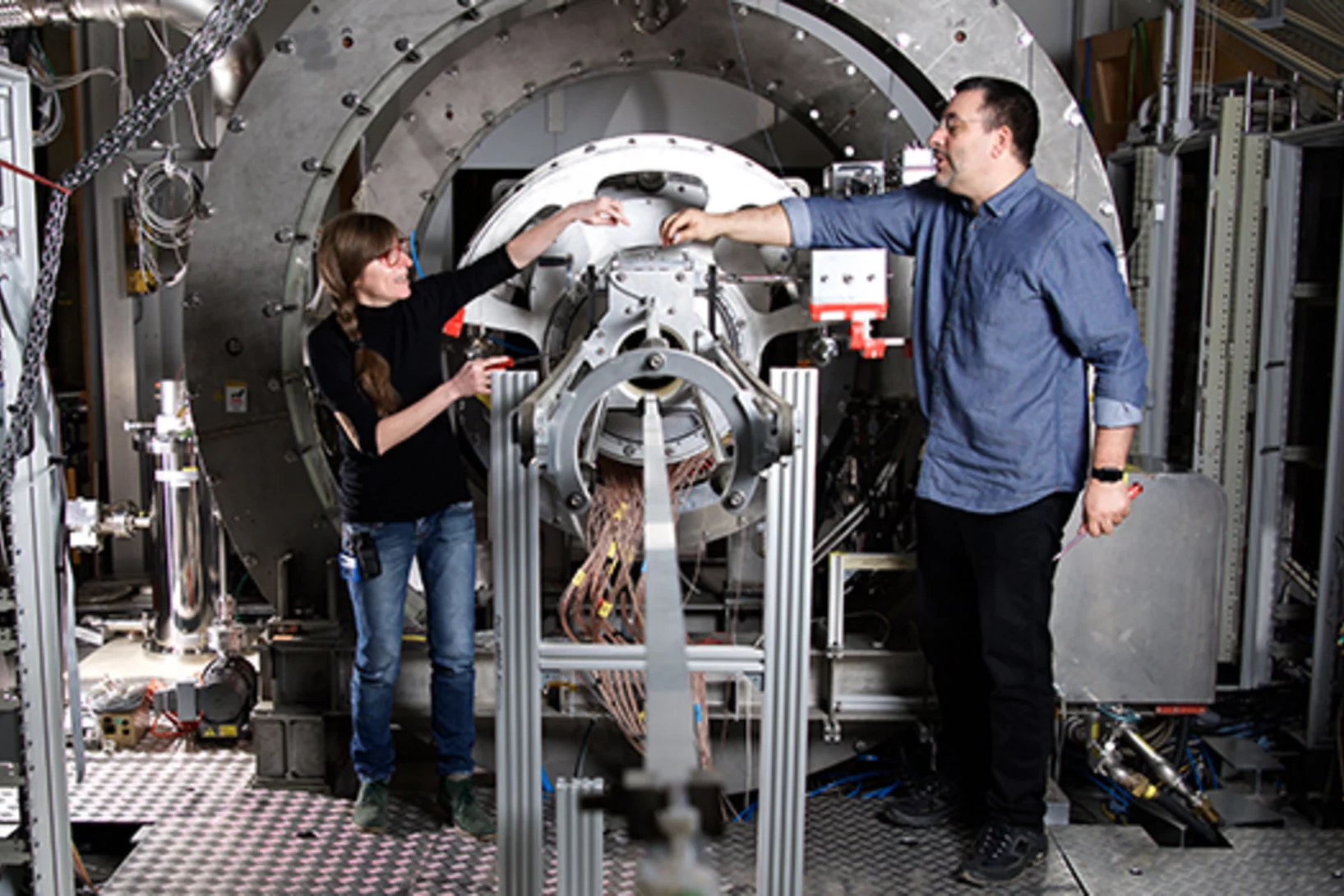At PSI, several projects are dedicated to important research questions concerning the Sars-CoV-2 coronavirus and the resulting diseases. We provide information on activities and projects, for example on investigations of lung tissue, on the production of proteins and antibodies or on ideas for new research on Covid-19.
Useful links
Towards hybrid pixel detectors for energy-dispersive or soft X-ray photon science
JUNGFRAU (adJUstiNg Gain detector FoR the SwissFEL Aramis User station) is a two dimensional hybrid pixel detector for photon science applications at free electron lasers and synchrotron light sources. The JUNGFRAU 0.4 prototype presented here is specifically geared towards low-noise performance and hence soft X-ray detection. With an extremely low noise of less than 30 electrons it enters a field formally reserved for SSD’s and CMOS imagers allowing single photon resolution down to a photon energy of 500eV.
From the Higgs boson to new drugs
A picture-perfect example of how basic research makes concrete contributions to the economy is the company DECTRIS — a PSI spin-off founded in 2006 and already highly successful. The latest development from DECTRIS is a detector called EIGER, which is used for X-ray measurements at large research facilities. There EIGER contributes, among other things, to the search for new drugs.
Semifluorinated Alkanes at the Air–Water Interface: Tailoring Structure and Rheology at the Molecular Scale
Semifluorinated alkanes form monolayers with interesting properties at the air–water interface due to their pronounced amphi-solvophobic nature and the stiffness of the fluorocarbons. In the present work, using a combination of structural and dynamic probes, we investigated how small molecular changes can be used to control the properties of such an interface, in particular its organization, rheology, and reversibility during compression–expansion cycles.
PSI-Feriencamp 2016
Suchen Sie für Ihr Kind ein spannendes Angebot während den Sommerferien? Möchten Sie in ihm die Neugier und Begeisterung für naturwissenschaftlich-technische Themen wecken? Die Berufsbildung und das Komitee für Chancengleichheit führt dieses Jahr zum achten Mal das PSI-Feriencamp durch!
Spin Liquid State in the 3D Frustrated Antiferromagnet PbCuTe2O6: NMR and Muon Spin Relaxation Studies
PbCuTe2O6 is a rare example of a spin liquid candidate featuring a three-dimensional magnetic lattice. Strong geometric frustration arises from the dominant antiferromagnetic interaction that generates a hyperkagome network of Cu2+ ions although additional interactions enhance the magnetic lattice connectivity.
Five hundred thousand times less likely than winning the lottery
Measuring the rarity of a particle decayIn the so-called MEG experiment at the PSI, researchers are searching for an extremely rare decay signature from a certain kind of elementary particles known as muons. More precisely, they are quantifying its improbability. According to their latest number, this decay occurs less than once in 2.4 trillion events. By means of this result, theoretical physicists can sort out which of their approaches to describing the universe will hold up against reality.
High-performance thermoelectric nanocomposites from nanocrystal building blocks
Using an assembly of colloidal nanocrystals a Ag-PbS nanocomposite was produced with increased thermoelectic figures of merit up to 1.7K at 850 K. EXAFS spectroscopy at the Ag K-edge was essential to show that Ag does not dissolve in PbS nanoparticles but preserved the individual nanodomains. This reduces the PbS intergrain energy barriers for charge transport
Spin excitations in copper selenate, a skyrmion host material
Inelastic neutron scattering measurements performed at EIGER and TASP have mapped the magnetic excitation spectrum along high-symmetry directions of the first Brillouin zone for the magnetic skyrmion host copper selenate, Cu2OSeO3. Most of the observed spectrum is consistent with a recently proposed model for the magnetic excitations in Cu2OSeO3, for which a new set of best-fit dominant exchange parameters has been found.
Spin excitations in copper selenate, a skyrmion host material
G.S. Tucker et al., Physical Review B 93, 054401 (2016). Inelastic neutron scattering measurements performed at EIGER and TASP have mapped the magnetic excitation spectrum along high-symmetry directions of the first Brillouin zone for the magnetic skyrmion host copper selenate, Cu2OSeO3.
Giant Controllable Magnetization Changes Induced by Structural Phase Transitions in a Metamagnetic Artificial Multiferroic
The realization of a controllable metamagnetic transition from AFM to FM ordering would open the door to a plethora of new spintronics based devices that, rather than reorienting spins in a ferromagnet, harness direct control of a materials intrinsic magnetic ordering. In this study FeRh films with drastically reduced transition temperatures and a large magneto-thermal hysteresis were produced for magnetocaloric and spintronics applications.
Stratified Micellar Multilayers - Toward Nanostructured Photoreactors
Polyelectrolyte multilayers (PEMs) with stratification of the internal structure were assembled from statistical amphiphilic copolyelectrolytes of opposite charges. These polyelectrolytes organize in aqueous solutions into micellar structures with fluoroalkyl and aromatic nanodomains, respectively, that were also preserved after deposition as thin films via layer-by-layer (LbL) electrostatic self-assembly.
In-situ visualization of stress-dependent bulk magnetic domain formation by neutron grating interferometry
The efficiency of industrial transformers is directly influenced by the magnetic properties of high-permeability steel laminations (HPSLs). These laminations are coated by insulating layers, to reduce eddy-current losses in the transformer core. In addition, the coating induces favorable inter-granular tensile stresses that significantly influence the underlying magnetic domain structure.
Origin of the Spin-Orbital Liquid State in a Nearly J=0 Iridate Ba3ZnIr2O9
We show using detailed magnetic and thermodynamic studies and theoretical calculations that the ground state of Ba3ZnIr2O9 is a realization of a novel spin-orbital liquid state. Our results reveal that Ba3ZnIr2O9 with Ir5+ (5d4) ions and strong spin-orbit coupling (SOC) arrives very close to the elusive J 1⁄4 0 state but each Ir ion still possesses a weak moment.
Medicines made to order with pinpoint precision
At PSI, scientists are developing new medicines against cancer. These contain radioactive substances that can be injected into the patients and thus make their way to the tumour. There, in direct contact, their radiation should destroy the cancer cells. Before such a radioactive medicine can be tested on patients in the first clinical trials, however, its safety must be guaranteed to ensure that the patient will not be harmed. Therefore every agent is produced at the PSI under sterile conditions and tested – separately for each patient, and only on the doctor's order.
Textbook on XAS and XES
During the last two decades, remarkable and often spectacular progress has been made in the methodological and instrumental aspects of x–ray absorption and emission spectroscopy. This progress includes considerable technological improvements in the design and production of detectors especially with the development and expansion of large-scale synchrotron reactors All this has resulted in improved analytical performance and new applications, as well as in the perspective of a dramatic enhancement in the potential of x–ray based analysis techniques for the near future.
Quasiparticle-continuum level repulsion in a quantum magnet
When the energy eigenvalues of two coupled quantum states approach each other in a certain parameter space, their energy levels repel each other and level crossing is avoided. Such level repulsion, or avoided level crossing, is commonly used to describe the dispersion relation of quasiparticles in solids.
Transport von aufgelösten Plutoniumlager des Bundes in die USA ist erfolgt
Im Januar und Februar 2016 wurden unter strengen Sicherheitsvorkehrungen rund 20kg Plutonium im Eigentum des Bundes in die USA transportiert. Es handelt sich dabei um Material, das seit den 1960er Jahren auf dem Areal des heutigen Paul Scherrer Instituts (PSI) gelagert worden war. Das Plutonium stammte aus wiederaufbereiteten Brennstäben des von 1960 bis 1977 betriebenen Forschungsreaktors Diorit. Der Bundesrat beschloss 2014 im Rahmen des Nuclear Security Summit-Prozesses, das Plutoniumlager aufzulösen und damit zur weltweiten Sicherung von Nuklearmaterial beizutragen.This news release is only available in French and German.
In situ stress observation in oxide films and how tensile stress influences oxygen ion conduction
Many properties of materials can be changed by varying the interatomic distances in the crystal lattice by applying stress. Ideal model systems for investigations are heteroepitaxial thin films where lattice distortions can be induced by the crystallographic mismatch with the substrate. Here we describe an in situ simultaneous diagnostic of growth mode and stress during pulsed laser deposition of oxide thin films.
Cooperation with nature
With SwissFEL, a new landscape takes shapeBarely completed, the building housing the X-ray free-electron laser SwissFEL has disappeared again beneath a mound of earth. Since then, planting and landscaping have been under way on and around this major research facility of the Paul Scherrer Institute PSI. Its special location, in a forest, demands that SwissFEL be integrated in an environmentally appropriate way. So the facility is, from the outside, nearly invisible. And rare animals and plants have gained new living space.
Decommissioning of the research reactor Proteus
Start of the public examination period for decommissioning of the nuclear facility Proteus at the Paul Scherrer Institute PSIThe nuclear research facility Proteus is a so-called zero-power reactor. In service, the thermal output of the reactor was limited to a maximum of 1 kW. That means this is an experimental reactor that was run at a power level so low that it did not require cooling. Proteus went into service in 1968. The PSI would like to decommission the facility. The decommissioning project is now being publicly announced in the legally prescribed, official publications.
Dramatic pressure-driven enhancement of bulk skyrmion stability
The recent discovery of magnetic skyrmion lattices initiated a surge of interest in the scientic community. Several novel phenomena have been shown to emerge from the interaction of conducting electrons with the skyrmion lattice, such as a topological Hall-effect and a spin-transfer torque at ultra-low current densities.
Developing a new drug against thyroid cancer
Researchers at the Paul Scherrer Institute PSI have developed a drug to trace and treat a particularly malignant strain of thyroid cancer more effectively. One advantage of the new drug is that it can be used to treat a strain of thyroid cancer where the established treatment is ineffective. The researchers at PSI have developed the new drug to such an extent that an initial study conducted on cancer patients at the University Hospital Basel can now get underway.
A micrometer-sized model of the Matterhorn
Researchers at the Paul Scherrer Institute have produced large numbers of detailed models of the Matterhorn, each one less than a tenth of a millimetre in size. With this, they demonstrated how 3-D objects so delicate could be mass-produced. Materials whose surface is covered with a pattern of such tiny 3-D structures often have special properties, which could for example help to reduce the wear and tear of machine parts.
Installation progress of the SwissFEL Linac
The installation of the linear accelerator (Linac) progresses very well. This week, the last girder of the so-called “Linac 1” was installed in the SwissFEL tunnel. The entire C-band accelerator consists out of Linac 1, Linac 2, and Linac 3, and a total amount of 104 accelerating structures. Meanwhile, 38 accelerating structures are installed in the SwissFEL tunnel. The assembly work on the remaining Linac modules will take place until end of September of this year. By then it is planned to finish the installation of all Linac modules in the SwissFEL tunnel.
The hotlab research facility
Start of the public examination period for renewed authorization to operate the research facility hotlab at the Paul Scherrer Institute PSIThe hotlab at the Paul Scherrer Institute PSI is a facility, unique in Switzerland, where researchers study highly radioactive materials in specially shielded chambers called hot cells. It serves the needs of applied materials research on highly radioactive samples from core structural components and fuel rods from nuclear power plants, research reactors, and the PSI radiation facilities. Through its operation of the hotlab, the Paul Scherrer Institute also contributes to the safety of the nuclear power plants in Switzerland. Around thirty staff members attend to the hotlab's safety technology and analysis infrastructure.
Proton Accelerator Operation Statistics 2015
For the first time in the history of the High Intensity Proton Accelerator the availability of the facility reached an outstanding value of 95% in 2015 with a record value of 99.3% in week 44. In comparison to the two previous years this corresponds to a reduction of the downtime by 50%. The user operation in 2015 was started as scheduled and already in the first week the machine was available 97% of the scheduled beam time. In addition to the smooth operation of the facility, high intensity beam experiments could regularly be performed with currents of up to 2.4 mA. nu
Coexistence of low-moment magnetism and superconductivity in tetragonal FeS and suppression of Tc under pressure
The family of iron-based superconductors has recently acquired a new member material, FeS. Theoretically, this compound has been shown to have electronic structure similar to that of the superconducting FeSe. However, contradictory ground states have been predicted for FeS. In this work, a collaboration of authors from Switzerland and Germany use muon spin rotation and relaxation to show that weak-moment magnetism microscopically coexists with bulk superconductivity.
Probing what sets the heart racing
New insights into the workings of important drug receptorsMany medical drugs operate on specific receptors located in the outer walls of our body’s cells. One of these is called the beta-1 adrenergic receptor. Among other things, it is responsible for palpitation, the racing pulse that we feel with stage fright or infatuation. How it transmits signals to the cellular interior can now be revealed in detail. These findings could help scientists better understand many drugs' mode of action.
Porträt Jenna Poonoosamy: Die Vermesserin der Gesteinsporen
Drei Jahre in Folge hat Jenna Poonoosamy den Preis für die beste Präsentation am Doktorandentag im Bereich Nukleare Energie und Sicherheit (NES) am Paul Scherrer Institut PSI erhalten. Poonoosamy stammt ursprünglich von der Insel Mauritius im Indischen Ozean. Schon in der Schule interessierte sie sich vor allem für Chemie. «Die meisten meiner Freunde wollten in die Wirtschaft», erzählt sie. «Mich dagegen haben die Naturwissenschaften fasziniert.» Und so zog sie nach der Schule zum Chemie-Studium nach Paris. Und kam später für ihre Doktorarbeit ans PSI.
At the interface
Interview with Stefan Janssen, Head of the User Office
Stefan Janssen is Head of the User Office at Paul Scherrer Institute PSI. In an interview, he explains why the PSI’s large research facilities are popular with researchers coming from other institutions, how he handles the many applications and how he supports users who come here to conduct experiments.




























